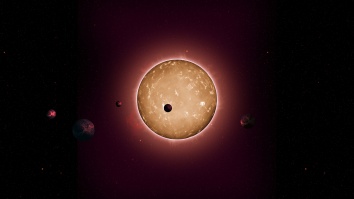Astronomers Discover Ancient Solar System with Five Earth-sized Planets
27 January 2015
A team of scientists including The University of Texas at Austin’s Dr. William Cochran has discovered a solar system similar to our own dating back to the dawn of our Milky Way galaxy. They are reporting the find of five planets with sizes between Mercury and Venus orbiting the Sun-like star Kepler-444 in today’s issue of The Astrophysical Journal.
“The discovery of this ancient planetary system shows that even the very old stars in our galaxy were accompanied by rich planetary systems,” Cochran said. “This tells us that there are nearby planets that are far, far older than the planets in our own solar system.”
This team, led by scientists from Britain’s University of Birmingham, based their discovery on observations made by the NASA Kepler satellite over four years. Cochran is a co-investigator of the Kepler mission.
All of the planets are much closer to their star than Earth is to the Sun, and orbit Kepler-444 in less than 10 days. Thus, this system may be thought of as a miniature version of the inner planets of our solar system.
The star Kepler-444 is 11.2 billion years old, having formed when the universe was less than 20 percent of its current age. This makes the Kepler-444 system the oldest known of terrestrial-sized planets — 2.5 times older than our solar system.
“The excellent facilities of The University of Texas McDonald Observatory were absolutely critical for helping us to understand the composition and age of the central star of this planetary system,” Cochran said. “This is just one example of the important complementary role that ground-based data from McDonald Observatory have played in the interpretation of results from several spacecraft missions.”
The team carried out the research using asteroseismology — listening to the natural resonances of the host star which are caused by sound trapped within it. These oscillations lead to miniscule changes, or pulses, in its brightness which allow the researchers to measure its diameter, mass, and age. The planets were then detected from the dimming that occurs when the planets passed in front of the star (an event called a transit). This fractional fading in the intensity of the light received from the star enables scientists to accurately measure the sizes of the planets relative to the size of the star.
“There are far-reaching implications for this discovery,” said Dr. Tiago Campante of The University of Birmingham, lead author of the study. “We now know that Earth-sized planets have formed throughout most of the universe's 13.8-billion-year history, which could provide scope for the existence of ancient life in [our] galaxy.”
Remarkably, by the time Earth formed, the planets in the Kepler-444 system were already older than our planet is today. This discovery may now help scientists to pinpoint the beginning of what may be dubbed the “era of planet formation.”
According to team member Professor William Chaplim of The University of Birmingham, “The first discoveries of exoplanets around other Sun-like stars in our galaxy have fuelled efforts to find other worlds like Earth and other terrestrial planets outside our solar system. We are now getting first glimpses of the variety of galactic environments conducive to the formation of these small worlds. As a result, the path towards a more complete understanding of early planet formation in the galaxy is now unfolding before us.” Chaplim has been leading the team studying solar-type stars using asteroseismology for the Kepler mission.
— END —
Science contact:
Dr. William Cochran, Research Professor
The University of Texas at Austin
512-471-6474; wdc@astro.as.utexas.edu







